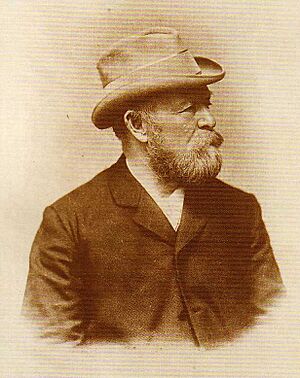Constantin Lipsius facts for kids
Johannes Wilhelm Constantin Lipsius (born October 20, 1832 – died April 11, 1894) was a German architect and a thinker about architecture. He is best known for designing the Royal Academy of Fine Arts and Exhibition Building in Dresden. This building, finished in 1894, is now called the Lipsius-Bau.
Constantin Lipsius: A Famous Architect
His Early Life and Training
Constantin Lipsius was born in Leipzig, Germany. After finishing high school, he studied architecture at the Leipzig Baugewerkenschule, which was a building trade school. In 1851, he spent three years studying at the Royal Art Academy of Dresden. There, he learned from Georg Hermann Nicolai, who was a famous architect and the person who took over from Gottfried Semper at the Academy.
After his studies, Lipsius traveled to Italy. He was very impressed by the buildings in Venice. Then, he went to Paris, France, where he worked for a short time. In Paris, he learned about the work of other important architects like Henri Labrouste and Charles Garnier. French ideas later influenced many of Lipsius's designs.
Designing Famous Buildings
Starting in the 1860s, Lipsius took part in many architecture competitions. He also designed homes and worked on restoring old buildings. In 1866, he won a competition to rebuild the Johannis Hospital in Leipzig. This success earned him the title of königliche Baurat, which means "royal architectural counsellor."
In the 1870s, Lipsius became even more active. In 1874, he became the president of a new group called the Union of Leipzig Architects. He also became the director of the Baugewerkenschule, where he had studied. From 1877 to 1889, Lipsius worked on restoring the famous Thomaskirche in Leipzig. This church is well-known because J. S. Bach worked there. Experts say his work on the church was one of the most important restoration projects in Saxony.
Lipsius also worked with another architect named August Hartel. Together, they designed the Peterskirche in Leipzig and the Johanneskirche in Gera.
The Royal Academy Building in Dresden
In 1881, Lipsius became a Professor of Architecture at the Dresden Academy. Soon after, he was asked to design a new building for the Academy. This project became very famous and was talked about in many national magazines.
Many people thought the building was too big for its location. Also, some felt it didn't match the local style of other famous architects like Semper. The fact that Lipsius got the job without a public competition also caused some anger among other architects.
Even today, opinions are mixed. The building has an unusual, pleated glass dome that locals call the "Lemon Press." Some people still find it strange. However, the design was very advanced for its time in the 1880s. It showed new ideas about how buildings could look and what they could represent.
His Ideas About Architecture
Lipsius was a thoughtful architect who wrote about his ideas. He believed in something called "architectural realism." This idea was about making architecture new and exciting again. Instead of just copying old building styles, Lipsius thought architects should look at the original meaning and power of building shapes and decorations.
He hoped that by doing this, architecture could grow and develop naturally. This approach helped pave the way for newer styles that came later, like Jugendstil and Art Nouveau. These styles were important steps towards what we now call "modern architecture."
Lipsius died in Dresden at the age of 61. Some believed his death might have been made worse by the criticism his main work, the Academy building, received. After his death, Paul Wallot, who designed the famous Reichstag building in Berlin, took over Lipsius's teaching position at the Academy.
List of Lipsius's Works
Private Buildings
- Funerary Chapel for Baroness von Eberstein, Schönefeld (Leipzig), 1855.
- Ernst Keil Residence, Leipzig, 1860–61.
- Frege Residence, Leipzig.
- Schloss Wetzelstein for Frege Family, Saalfeld.
- Mirror Hall in Schützenhaus, Leipzig, 1876.
- Café Felsche (also known as Café Français), Leipzig.
- Schloss Klein-Zschocher for Baron von Tauchnitz, Leipzig.
- Frege Chapel, Abtnaudorf (Leipzig), 1888–89.
- Mausoleum for Graf von Fabrice, Dresden, 1891–93.
- Restaurant Baarmann, Leipzig.
Public Buildings
- Johannis-Hospital, Leipzig, 1867–72.
- Stock Exchange, Chemnitz, 1864–1867.
- Exhibition Hall, Leipzig Applied Art Exhibition, 1879.
- Royal Art Academy and Exhibition Building, Dresden, 1883–1894 — now called Lipsius-Bau.
Churches and Sacred Buildings
- Church, Wachau, 1866-7.
- Johanniskirche, Gera.
- Petrikirche (with August Hartel), Leipzig, 1877–1885.
- Nathanaelkirche (with August Hartel), Leipzig-Lindenau, 1882–1884.
Restoration and Preservation Work
- Hotel Russie, Leipzig.
- Jacobikirche Tower, Ölsnitz i. Vogtland, 1866–68.
- Reconstruction of Borna Parish Church, Borna, 1866–68.
- Reconstruction of Tower at St. Peter's, Bautzen.
- Reconstruction/Enlargement of Schloss Hohenthal, Püchau, 1873–79.
- Reconstruction of Thomaskirche, Leipzig, 1878–89.
- Protective Porch added to the Goldene Pforte, Freiburg, 1883–89.
Competitions He Entered


